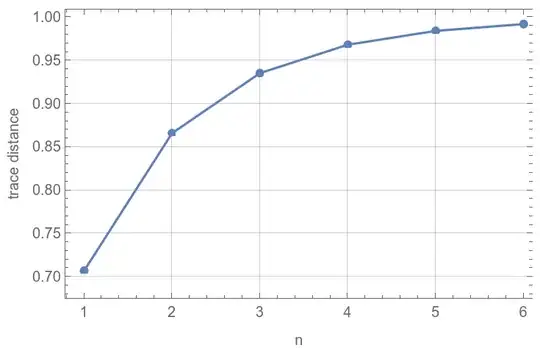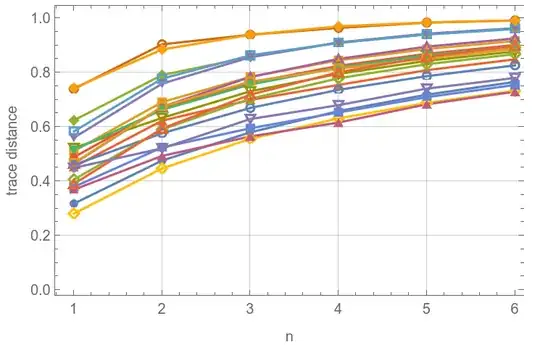Very roughly speaking, yes, "entangled measures" (that is, global measures on multiple copies) make it easier to distinguish states.
The intuitive reason is that, if $\langle\rho,\sigma\rangle\equiv\operatorname{Tr}(\rho\sigma)<1$, then $\langle\rho^{\otimes n},\sigma^{\otimes n}\rangle=\langle\rho,\sigma\rangle^n$, which decreases with increasing $n$. You can then see that in the limit $n\to\infty$, the states become orthogonal, and thus perfectly distinguishable.
For example, if you take $\rho=|0\rangle\!\langle0|$ and $\sigma=|+\rangle\!\langle+|$ and compute the trace norm $\|\rho^{\otimes n}-\sigma^{\otimes n}\|_1$ as a function of $n$ (which you'll remember from the linked post, and the discussion in this post, gives you the maximum distinguishing probability), you get

If you do the same for randomly generated three-dimensional states, you always get a similar behaviour:

To see that these better performance are made possible by entangled measures, consider again $\rho=|0\rangle\!\langle0|$ and $\sigma=|+\rangle\!\langle+|$. The corresponding Helstrom measurement is
$$\Pi_\pm \equiv \mathbb P[(-1\pm \sqrt2)|0\rangle+|1\rangle],
\qquad \mathbb P[|\psi\rangle]\equiv\frac{|\psi\rangle\!\langle\psi|}{\langle\psi|\psi\rangle}.$$
On the other hand, the Helstrom measurement corresponding to $\rho^{\otimes 2}-\sigma^{\otimes 2}$ is
$$\Pi_\pm = \mathbb P[(-3\pm2\sqrt3)|00\rangle+|01\rangle+|10\rangle+|11\rangle],$$
which are clearly projections on entangled states.
The figures above were generated with the following MMA snippets:
KP[arg_] := arg;
KP[args___] := KroneckerProduct[args];
traceDistance[dm1_, dm2_] := dm1 - dm2 // Eigenvalues // Abs // Total // #/2 &;
With[{rho = {{1, 0}, {0, 0}}, sigma = {{1, 1}, {1, 1}}/2},
Table[
traceDistance[KP @@ ConstantArray[rho, n], KP @@ ConstantArray[sigma, n]],
{n, Range@6}
] // ListPlot[#,
Joined -> True, PlotMarkers -> Automatic,
GridLines -> Automatic, PlotRange -> All, Frame -> True,
FrameLabel -> {"n", "trace distance"}] &
]
and
KP[arg_] := arg;
KP[args___] := KroneckerProduct[args];
traceDistance[dm1_, dm2_] := dm1 - dm2 // Eigenvalues // Abs // Total // #/2 &;
randomDM[dim_Integer] := RandomComplex[{-1 - I, 1 + I}, {dim, dim}] // Dot[#, ConjugateTranspose@#] & // #/Tr@# &;
data = Table[
With[{rho = randomDM@3, sigma = randomDM@3},
Table[
{n, traceDistance[KP @@ ConstantArray[rho, n], KP @@ ConstantArray[sigma, n]]},
{n, Range@6}
]],
20
];
ListPlot[data,
Joined -> True, PlotMarkers -> Automatic,
GridLines -> Automatic, PlotRange -> All, Frame -> True,
FrameLabel -> {"n", "trace distance"}
]

